MAB2137
Anti-Homing Receptor Antibody, clone A020
clone A020, Chemicon®, from rat
Sinónimos:
CD44s, HCAM, Pgp-1
About This Item
Productos recomendados
origen biológico
rat
Nivel de calidad
forma del anticuerpo
purified antibody
tipo de anticuerpo
primary antibodies
clon
A020, monoclonal
reactividad de especies
mouse, human, rat, pig, rabbit, canine, bovine
fabricante / nombre comercial
Chemicon®
técnicas
ELISA: suitable
flow cytometry: suitable
immunocytochemistry: suitable
immunohistochemistry: suitable
western blot: suitable
isotipo
IgG2b
Nº de acceso NCBI
Nº de acceso UniProt
Condiciones de envío
dry ice
modificación del objetivo postraduccional
unmodified
Información sobre el gen
human ... CD44(960)
Especificidad
Inmunógeno
Aplicación
Flow Cytometry :1:1000
Immunofluorescence 1:200
Immunohistostaining of paraffin embedded tissues. 1:250; antigen retrieval is usually not needed.
Immunoprecipitation 1:200
Western blotting: non-reduced conditions only; 90kDa band is detected; blocking PBS/5% milk protein, primary antibody dilution 1:1000 o/n incubation.
Optimal working dilutions must be determined by end user.
Cell Structure
Adhesion (CAMs)
Descripción de destino
Forma física
Almacenamiento y estabilidad
Nota de análisis
Cells of epithelium and highly expressed by carcinomas
Otras notas
Información legal
Cláusula de descargo de responsabilidad
Not finding the right product?
Try our Herramienta de selección de productos.
Código de clase de almacenamiento
12 - Non Combustible Liquids
Clase de riesgo para el agua (WGK)
WGK 2
Punto de inflamabilidad (°F)
Not applicable
Punto de inflamabilidad (°C)
Not applicable
Certificados de análisis (COA)
Busque Certificados de análisis (COA) introduciendo el número de lote del producto. Los números de lote se encuentran en la etiqueta del producto después de las palabras «Lot» o «Batch»
¿Ya tiene este producto?
Encuentre la documentación para los productos que ha comprado recientemente en la Biblioteca de documentos.
Nuestro equipo de científicos tiene experiencia en todas las áreas de investigación: Ciencias de la vida, Ciencia de los materiales, Síntesis química, Cromatografía, Analítica y muchas otras.
Póngase en contacto con el Servicio técnico








